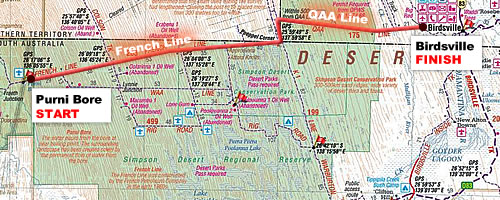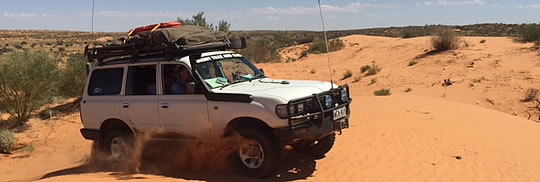In 2015 the Simpson Desert Bike Challenge featured a new route traversing the French Line.
Video of the French Line Survey – Alan Keenleside (Race Director)
Here is a blow by blow description of what to expect when you tackle the big dune country.

So what’s it going to be like to ride this year’s course? Exciting. Fun. Challenging. Hard. Soft. Fast, flat, steep and slow. But mainly, you can be sure of dunes.
On Day 1 we’re looking at 108 km.
Stage 1. Dune Resurrection. 68km.
We know and love the road out of Purni Bore with its low dunes and fast riding. At Wonga Junction we normally turn south onto the Rig Road. This year we head straight on. Immediately we’re amongst the big dunes. These are what I call dune complexes; multiple small dunes that have become stacked together. This is great riding with multiple crests, twists and dips as the trail wanders back and forth over the dune complex. The track here is single vehicle track, two wheel ruts with a central clear section. It’s also tight with little opportunity to leave the track. The conditions on the survey were very firm and perhaps the middle of the track will stay that way. It’s too narrow to get disturbed by 4WD traffic.

Remember the Sweep Speed will be reduced from 12km/h to 10km/h whenever you are on the French Line, so you’ll have time to enjoy the dunes.
At 68km we reach the junction with the Colson Track. This will be our lunch stop and night camp.
Be warned: The track between Wonga Junction and Colson Track (maybe further) is littered with nasty multipointed thorns that may cause a problem for tubed tyres!
Stage 2. Swanky Swale. 40km.
Weather permitting, this stage will be hugely fast. We head south over hard clay pack for 20km then turn around for 20km back north. Last year I said Stage 2 was easy and then lost half the field, so, obviously, the weather can make a huge difference but no-one should have a problem with the terrain. Sweep Speed is 12km/hr.
Day 2 and we come to the heart of the matter. This is a short day of 89km with non-stop dunes.
Stage 3. The Belly of the Beast. 54km
 Leaving the junction of the Colson Track, we’re straight back into the dunes. My survey on this stage is full of notes like “Big dune riding!” “Fun riding with twists and dips!” “Big dune complex!” “Gorgeous Dune!”
Leaving the junction of the Colson Track, we’re straight back into the dunes. My survey on this stage is full of notes like “Big dune riding!” “Fun riding with twists and dips!” “Big dune complex!” “Gorgeous Dune!”
It’s going to be great morning for those on the bikes. There are many multi-topped dunes where the trail winds up and around the crests with dips and turns. At the crests the brave may find it faster going straight over the top, or may find their doom in the soft lee sand. Occasionally the dunes give way to wide swales. Towards the end of the stage we see smaller dunes and wider swales.
Stage 4. Sandy Sojourn. 35km
The dunes are generally lower and the swales longer for this afternoon stage. There is still some great riding to be had on big multi-topped dunes early in the stage but the terrain eases after the first water stop. We stop at the junction with Knolls Track. This will be our campsite for the night and also tomorrow’s lunch stop.
On Day 3 we run south in the morning, before coming to what I believe will the crux of this year’s crossing in the afternoon.
Stage 5. Gnarly Knolls. 70km.
Stage 5 is 35km out and back, mainly flat with a few dune crossings. This stage sounds easy but don’t underestimate it. The track starts down past the Approdinna Attora Knolls. The track twists and turns here as cars have tried to find a smooth path over the gypsum nodules that stud the road. Watch out for air over these bumps. There is a small salt lake after 8km that would be smooth riding but it’s the wrong way to go.
At around 15km it’s time to climb from one swale over in the next. The track widens out and there are corrugations to test the comfort of your saddle.
After 20km it’s time to change swales again with a brief section riding along a dune crest. From there it’s a single vehicle track through open bush down to the turn.
After the turn head back north and say hi to your mates still heading south. Retrace your steps (tyre treads) back to the junction.
The terrain is easier on this stage but there is still plenty of meat here. Difficulties will arise if it’s hot or windy.
Stage 6 Poeppel’s Crux. 42km.
 I really think this stage is going to be the crux for those riders wanting a 100% Dune Rider medal. This certainly was the hardest section by 4WD. Yesterday the dunes eased as the afternoon stage progressed, today they build. In the heat of the afternoon this has the potential to be a hard stage.
I really think this stage is going to be the crux for those riders wanting a 100% Dune Rider medal. This certainly was the hardest section by 4WD. Yesterday the dunes eased as the afternoon stage progressed, today they build. In the heat of the afternoon this has the potential to be a hard stage.
Starting with low dunes and wide flat plains, the dunes start building after the first salt lake at 11km. Some dunes are low but have soft tops – even the four wheel drives will have to be on their guard. After 20km it all gets a little out of hand, with consistent mid-sized dunes and building dune complexes. Great riding with swoops and twists along the trail.
At 30km there are more big dunes and yet more chances to get the convoy bogged but after this things do settle down. A salt lake (Lake Poeppel) at 40km serves to mark the end of the dunes. It’s a brief run here up to the camp at Poeppel Corner.
On Day 4 we return to standard race distances, 80km in the morning and 54km in the afternoon. After all you’ve been through this is a full day out. Riders sitting on 100% will still need to knuckle down on day 4.
Stage 7. Racing Snake. 80km Leaving the campsite at Poeppel’s corner, there are a couple of decent dunes before we hit another salt lake and head north on the K1. The salt lake is fast going north to the turn at 20km and a good chance to get some early morning sunrise shots. Heading east there is a smooth crossing across the salt lake before, game on, and we hit the big dunes of the QAA line. The QAA has a different character to the French line. The dunes here, though big, are separated by huge swales. Swoop down the dunes, recover on the swale then look ahead to pick your line up the next dunes. A long stage at 80km. Sweep speed on the QAA line will be 12km/hr.
Stage 8. Nappanerica Dreaming. 54km. The afternoon stage is a full 54km, but the dunes fade as we head across Eyre Creek. Firm surfaces and a few trees will be a blessing to the legs and eyes in turn. I’m sure most riders will be dreaming of Big Red long before it comes into sight. Once close we actually turn south, towards Little Red, the last big dune you have to climb on this course. There is a free beer to any rider that clears Little Red. It’s a challenge on tired legs to keep your momentum on this long climb. The finish line is over the top, down on the Birdsville side. If riders are still close at this point there are minutes to be made on this last climb. We camp under the trees with nothing but a brief cruise on top of Big Red and a graded road separating us from the bar at Birdsville.
Day 5. An unusual day.
Stage 9. Look to Windward. 20km. I really wish I was riding this stage. There will be only two course markers on this stage, one at Little Red and one at Big Red. The course follows the dune crest and you’re welcome to find your own way (just stay off the plants). Turn each course marker on the right shoulder, that is clockwise, to avoid collisions. This is untracked sand riding.
 Conditions may deteriorate as bikes break through the crust. It’s 2.5km from Little Red to Big Red, then 2.5km back. Repeat that four times for the 20km stage. I’m sure the crews will come out to cheer. You’ll be lucky to complete this stage in the saddle, though some brave soul with good sand skills might make it without putting a foot down. My advice is in the title.
Conditions may deteriorate as bikes break through the crust. It’s 2.5km from Little Red to Big Red, then 2.5km back. Repeat that four times for the 20km stage. I’m sure the crews will come out to cheer. You’ll be lucky to complete this stage in the saddle, though some brave soul with good sand skills might make it without putting a foot down. My advice is in the title.
Stage 10. Birdsville Bar Blast. 35km. After lunch it’s time to head for the bar with 35km of graded road into Birdsville. Traditionally the final stage has been neutral, with the stronger riders helping to ensure that everybody makes it through. As a Race Director, I won’t enforce that. It’s a race. I respect every rider’s opportunity to race within the rules. Any organisation of this stage is solely up to the riders. Still, it warms my heart to see this happen. The desert is a challenge and it’s your fellow humans that help you make it through. You’ve come a long way, you’re tired, but you’re still strong and nothing now can stop you from reaching the finish.
A Note on Sweep Speeds :-
We’ll be on the French Line from Purni Bore to Poeppel Corner. The Sweep Speed on the French Line will be reduced to 10km/hr because of the large number of dunes. The Sweep Speed will be 12km/hr everywhere else. To be explicit, Stages 1, 3, 4 and 6 will have a Sweep Speed of 10km/hr, Stages 2, 5, 7, 8 and 10 will have a Sweep Speed of 12km/hr.
Stage 9, Look to Windward, will have no Sweep vehicle following the riders. Riders will be given two hours to complete the stage. You can drop out of this stage at either end (at a 2.5km interval). If you run over two hours on the last leg, distance will be docked at the rate of 6 minutes = 1km (eg. if a rider finishes in 2:06, their distance will be recorded as 19km).
